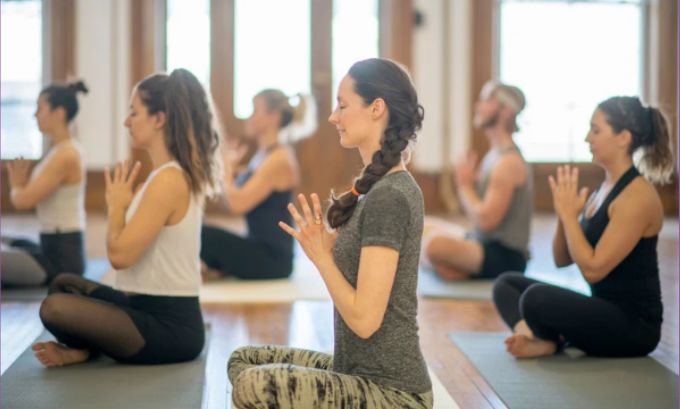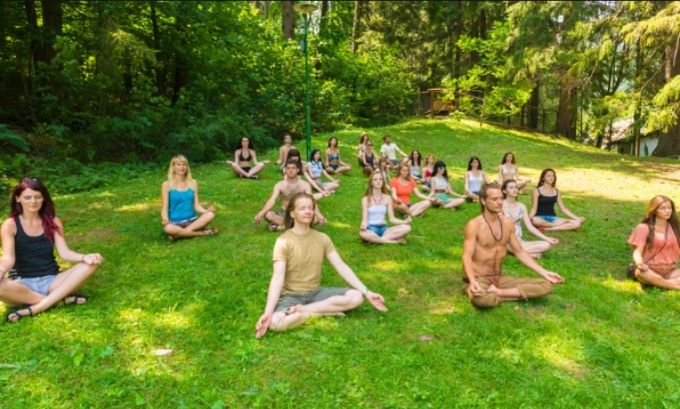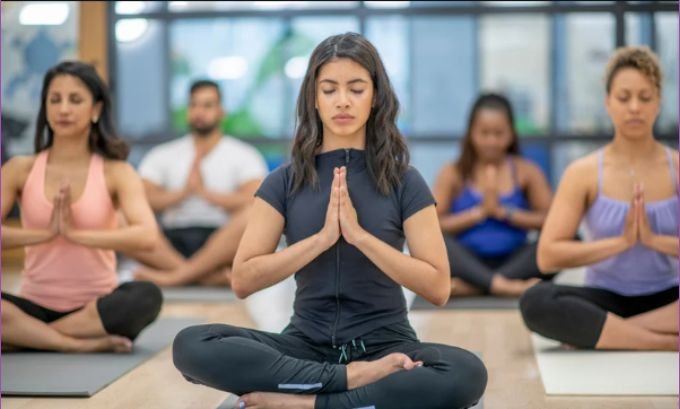If you’ve ever felt intimidated by the idea of yoga, you’re not alone. Images of people twisted into seemingly impossible shapes can make the practice feel out of reach for the average person. But yoga is far more than just impressive poses. At its core, it is a practice that connects the body, breath, and mind.
This guide will demystify yoga, exploring its ancient origins, the science-backed benefits, and the various styles you can try. You’ll learn that yoga is a personal journey, accessible to everyone, regardless of age, fitness level, or flexibility. By the end, you’ll have a clear understanding of what yoga is and how you can begin to incorporate it into your life.
Table of Contents
The Roots of Yoga: More Than Just a Workout
Yoga is an ancient practice with roots stretching back over 5,000 years to ancient India. The word “yoga” comes from the Sanskrit word “yuj,” which means “to unite” or “to join.” This refers to the union of individual consciousness with universal consciousness, symbolizing a harmony between mind and body.
Historically, yoga was a comprehensive spiritual discipline aimed at achieving a state of enlightenment or liberation (moksha). The physical postures, known as asanas, were just one of the “Eight Limbs of Yoga” described in the Yoga Sutras of Patanjali, a foundational text compiled around 400 CE. These eight limbs provide a guide to living a meaningful and purposeful life.
The eight limbs are:
- Yama: Ethical standards and sense of integrity.
- Niyama: Self-discipline and spiritual observances.
- Asana: Physical postures.
- Pranayama: Breath control.
- Pratyahara: Withdrawal of the senses.
- Dharana: Concentration.
- Dhyana: Meditation or contemplation.
- Samadhi: A state of ecstasy or enlightenment.
While modern yoga often focuses heavily on the physical postures (asanas), the ultimate goal remains the same: to create balance and unite the body, mind, and spirit.

The Science-Backed Benefits of a Consistent Practice
The growing popularity of yoga in the Western world isn’t just a trend; it’s supported by a growing body of scientific research. A regular yoga practice can offer profound benefits for both physical and mental health.
Physical Health Benefits
- Improved Flexibility and Balance: This is one of the most well-known benefits. Consistent practice lengthens muscles and increases the range of motion in your joints. Poses that challenge your stability, like Tree Pose, enhance balance and coordination, which is especially important as we age.
- Increased Strength: Many yoga poses require you to support your own body weight in various ways. Poses like Plank and Downward-Facing Dog build functional strength throughout your entire body, from your arms and shoulders to your core and legs.
- Better Posture and Reduced Back Pain: Yoga strengthens core muscles, which are essential for supporting the spine. A 2017 study found that a 12-week yoga program significantly reduced pain for individuals with chronic lower back pain. By increasing body awareness, you also become more mindful of your posture throughout the day.
- Enhanced Heart Health: Some studies suggest that yoga can help reduce risk factors for heart disease. Regular practice has been shown to lower blood pressure, reduce cholesterol levels, and slow the heart rate.
Mental Health Benefits
- Stress and Anxiety Reduction: Yoga is a powerful tool for managing stress. It helps lower cortisol, the primary stress hormone. The focus on deep, mindful breathing (pranayama) activates the parasympathetic nervous system, which induces a state of relaxation.
- Improved Mood: Physical activity is a known mood booster, and yoga is no exception. Research has shown that practicing yoga can increase levels of GABA, a neurotransmitter in the brain that is often low in people with depression and anxiety disorders.
- Enhanced Focus and Concentration: The practice of holding poses and focusing on the breath trains the mind to stay present. This can translate to improved concentration and mental clarity in other areas of your life.
- Better Sleep Quality: The relaxing effects of yoga can help you fall asleep faster and stay asleep longer. Many people find that a gentle evening yoga routine is an effective way to wind down and prepare for a restful night.
Finding Your Style: A Guide to Common Types of Yoga
With so many different styles of yoga available, it can be hard to know where to start. Each style offers a unique experience, so exploring a few can help you find the one that best suits your personality and goals.
| Yoga Style | Description | Best For |
|---|---|---|
| Hatha | A gentle, slow-paced class. It’s an umbrella term for any yoga that teaches physical postures. A Hatha class will likely be a good introduction to basic poses. | Beginners, those looking for a relaxing and less strenuous practice. |
| Vinyasa | Characterized by flowing from one pose to the next, synchronized with the breath. Classes can be dynamic and physically demanding. | Those who enjoy a faster pace and a good workout. Intermediate levels. |
| Ashtanga | A structured and vigorous style that follows a specific sequence of postures. It’s a physically demanding practice that builds internal heat. | Experienced yogis, individuals seeking a disciplined and challenging practice. |
| Iyengar | Focuses on precise alignment in each pose. Props like blocks, straps, and blankets are often used to help students achieve the correct form. | Beginners, people with injuries, and those who are detail-oriented. |
| Bikram | A set sequence of 26 poses and two breathing exercises performed in a room heated to 105°F (40°C) with 40% humidity. | People who love to sweat and are looking for an intense, structured workout. |
| Yin | A slow-paced, meditative style where poses are held for longer periods (3-5 minutes or more). It targets the deep connective tissues, like ligaments and fascia. | All levels, especially those needing to increase flexibility and practice mindfulness. |
| Restorative | A very gentle and relaxing practice that uses props to support the body completely. The goal is deep relaxation and healing. | Anyone seeking stress relief, recovering from illness, or simply needing to relax. |
This is not an exhaustive list, but it covers some of the most common styles you’ll find at local studios or online. Don’t be afraid to try a few different classes to see what resonates with you.

Your First Class: What to Expect
Walking into your first yoga class can be a little nerve-wracking, but knowing what to expect can help ease any anxiety.
- What to Wear: Choose comfortable, breathable clothing that allows you to move freely. Athletic leggings or shorts and a fitted top are good options.
- What to Bring: Most studios provide mats and props, but you might prefer to bring your own mat. Also, bring a water bottle and a small towel.
- Class Etiquette: Arrive a few minutes early to set up your mat and settle in. Let the instructor know you’re new; they can offer modifications and extra guidance. It’s also best to avoid wearing strong perfumes.
- Listen to Your Body: This is the most important rule in yoga. If a pose doesn’t feel right or causes pain, gently back off. The instructor is there to guide you, but you are the ultimate authority on your own body.
Frequently Asked Questions
Q: Do I need to be flexible to do yoga?
A: Absolutely not! This is one of the biggest myths about yoga. Flexibility is a result of practice, not a prerequisite. Yoga meets you where you are.
Q: Can I do yoga if I have an injury?
A: It depends on the injury. It’s always best to consult with your doctor first. If you get the all-clear, inform your yoga instructor about your injury before class so they can provide appropriate modifications. A gentle or restorative style is often a good starting point.
Q: How often should I practice yoga to see benefits?
A: Even practicing once a week can make a difference. For more significant results, aim for 2-3 times per week. Consistency is more important than frequency. A short, 15-minute daily practice can be more beneficial than one long class per week.
Q: Can yoga help me lose weight?
A: While yoga is not typically considered a high-intensity cardio workout, it can support weight loss. More vigorous styles like Vinyasa and Ashtanga burn more calories. Furthermore, yoga can reduce stress (which can contribute to weight gain) and promote mindful eating habits.
Begin Your Yoga Journey
Yoga is a rich and multifaceted practice that offers a pathway to a healthier body and a calmer mind. It’s a personal journey of self-discovery, not a competition. Whether you seek physical fitness, mental clarity, or a deeper spiritual connection, yoga has something to offer.
The best way to understand yoga is to experience it for yourself. Find a beginner’s class online or at a local studio, roll out a mat, and simply begin. The path of yoga starts with a single breath.
Practicing yoga for flexibility and balance is a journey, and combining it with healthy lifestyle products from Tokyo Mart can make the experience even more fulfilling
